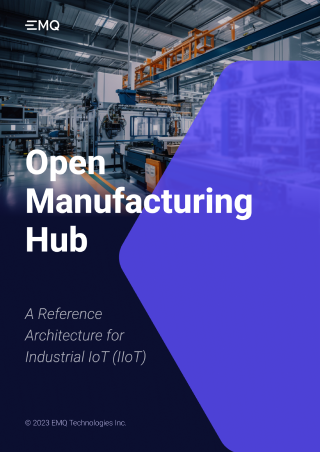Modern Messaging Infrastructure for Smart Manufacturing

Table of Contents
Challenges for Traditional Manufacturing
Running a manufacturing business is a multifaceted and demanding endeavor. Almost all companies face significant challenges, including managing large-scale production processes, maintaining product competitiveness, and navigating various operational complexities. To remain competitive, manufacturing companies consistently seek ways to improve their overall performance. Key areas for enhancement typically include:
- Operational Efficiency
- Quality Assurance
- Asset Optimization
- Supply Chain Optimization
- Product Innovation
- Environment Sustainability
Different industries prioritize different challenge areas based on their specific needs and goals. For example, logistics companies may focus on optimizing their supply chain management processes, while food companies may prioritize ensuring the highest standards of food quality. Each industry tailors its focus to meet the unique needs and requirements of its operations. In general, these improvements can be grouped into the six main categories mentioned above.
Industry 4.0 Approach
To address these challenges, a significant number of companies are choosing to adopt Industry 4.0 technologies as part of their strategic approach. The adoption of these advanced technologies is intended to accelerate the digital transformation of their manufacturing facilities. By leveraging Industry 4.0 principles and solutions, companies aim to revolutionize their operations and achieve higher levels of automation, more comprehensive product quality tracking systems, faster production scalability, and improved sustainability.
Blind Spot for Adopting New Technologies
Before budgeting and implementing new technologies, it is critical for companies to assess the capacity and capabilities of their current IT and OT infrastructure.
Interoperability of disparate IT and OT systems is a common issue that most companies would overlook. It's better to:
- Assess the compatibility of existing IT and OT systems with new technologies to ensure no compatibility issues between different systems and devices.
- Plan for necessary integrations or updates to ensure seamless communication and data exchange.
In addition to interoperability, scalability is an important consideration when adopting new technologies. Companies should also consider the following:
- Whether the current infrastructure can scale to support the companies' anticipated growth in data storage and processing requirements.
- The requirement of expanding server capacity, increasing storage capacity, and optimizing data management processes when adding large data processing systems.
Legacy Manufacturing Information Infrastructure
In traditional automation systems, direct communication between management-level systems such as ERP or MES and field-level sensors and devices is limited. The primary communication flow follows a hierarchical structure within the automation pyramid, where data from field-level sensors and devices is collected and processed by control-level devices, such as PLCs and SCADAs, before being shared with the management level.
Cascade Data Flow
The flow of information in the automation pyramid generally follows a cascade-like pattern, with data flowing from the bottom (field level) to the top (management level), while control commands or instructions typically flow from the top to the bottom. This pattern of information flow is a fundamental characteristic of the automation pyramid. As a result, communication between the top management IT level and the bottom device OT level is isolated. A large amount of production data is stored or neglected within OT-level systems and devices such as PLCs and SCADA.

Manual Data Analysis for Traditional Manufacturing
In response to this problem, some large companies use data collection software such as Kepware to periodically collect data from field-level devices and control-level SCADA. This data includes various measurements, process variables, alarms, and other relevant information. It is critical to ensure accurate and reliable data collection to provide a solid foundation for subsequent analysis. Spreadsheet tools such as Microsoft Excel or Google Sheets are widely used for basic data analysis. In addition, tools such as Tableau, Power BI, or QlikView allow users to create visually appealing data visualizations that make it easier to explore and present insights. Of course, such data manipulation is part of manual batch processing for data analysis. It is not as efficient as automated and real-time data processing. More components and systems are added to the information infrastructure. However, more communication channels are created, making data exchange more complicated.

Central Manufacturing Data Hub
As mentioned above, new technologies may create compatibility issues with existing components or systems within the automation pyramid. Different devices, protocols, or software may not seamlessly integrate or communicate with each other. Ensuring compatibility and establishing proper interoperability between new and existing technologies can be a significant challenge. Downtime, system reconfiguration, or training requirements can temporarily impact productivity and workflow.
Centralized Data Repository
EMQ introduces a solution called Open Manufacturing Hub (OMH) to ensure interoperability and scalability of the manufacturing information infrastructure by establishing a more flexible and connected approach to data exchange. OMH establishes a centralized data repository to store and manage all data collected from different levels of the automation pyramid. This repository acts as a central hub where data from field-level devices, control-level systems, and management-level applications is consolidated.

In the OMH architecture, data can flow bi-directionally between different levels of the automation pyramid. While the traditional cascade-like flow of data from the field level to the management level remains relevant, the OMH enables more dynamic and direct communication between different levels. Data can be accessed and used by multiple levels, enabling real-time monitoring, analysis and control.
The OMH provides standardized methods for data access via the EMQX broker. It allows authorized users and applications to subscribe to data from any information system in the automation pyramid using consistent and well-defined MQTT interfaces. The OMH also provides standardized methods for device data acquisition through the Neuron gateway. It allows different devices with different data formats to communicate with any other system or device.

IT and OT Convergence
The OMH can facilitate interoperability between IT and OT systems within the automation pyramid by providing a rich set of OT industrial protocol communications and IT application connectors, enforcing MQTT standardization for different data formats. It harmonizes data, ensuring consistency and compatibility between components and systems. Standardization enables smoother collaboration and convergence efforts, breaking down information silos.

By collecting and storing real-time data from OT systems, the OMH enables real-time monitoring and control of manufacturing processes. This facilitates better operational visibility, proactive decision making, and timely intervention to resolve problems or optimize performance. Real-time data from OT systems can be combined with data from IT systems to provide a comprehensive view of the manufacturing environment.
Contextualization
This type of IT and OT data combination is the process of data normalization and contextualization, which means combining data from many different sources, such as field-level devices, control systems, and management-level applications, into a single source of information. This integration enables better contextualization by bringing together data from different parts of the manufacturing process.
In fact, contextualized data is one of the most important features that OMH can provide to analytical applications such as AI/ML. By providing additional context and metadata, AI/ML models can better understand and interpret data, reducing errors and improving accuracy. Therefore, implementing OMH can lead to an improvement in the predictive capabilities of analytic models.
In conclusion, OMH can change the cascade-like data flow in the automation pyramid to a unified namespace architecture. In general, incorporating OMH into the information infrastructure is just like implementing a unified namespace architecture, which provides the following benefits.
- Simplified Data Access
- Improved Collaboration
- Contextualized Data
- Simplified IT Administration
- Scalability and Flexibility
- Interoperability
- Data Consistency
- Improved Data Integrity
- AI/ML Precise Prediction
Multi Sites Manufacturing
By leveraging the high throughput and low latency capabilities of the EMQX broker, OMH can provide high-speed data replication across multiple sites. High-speed data replication across multiple manufacturing sites ensures the consistency of data shared between sites. When data is replicated, each site has access to the same set of information, ensuring that decisions and actions are based on the most current and synchronized data. This promotes operational consistency, reduces inconsistencies, and enables standardized processes across all sites.

Data replication supports scalability and facilitates the expansion of manufacturing operations to new locations. As new sites are added, data can be replicated to those sites, allowing them to quickly access relevant information and integrate into the overall manufacturing ecosystem. This scalability helps streamline operations, accommodate growth, and maintain consistent data across the extended manufacturing network.
Distributed Stream Processing Framework
Replicating data to multiple manufacturing sites enables local data access and processing with our edge processing application eKuiper, which is an edge lightweight IoT data analytics/streaming software. Each site can access and manipulate the replicated data locally, reducing the latency and network traffic associated with accessing data from a central location. This improves performance, enables faster response times, and ensures smoother operations within each site.
On-Premise Central Control Room
With data from multiple applications and systems in multiple locations integrated into the high-speed OMH in the central control room at headquarters, operators and engineers can view real-time data, alarms and performance metrics through visual dashboards and interfaces. This real-time monitoring provides immediate insight into the status of operations, enabling timely responses and proactive management of manufacturing processes.

Virtual Analytic Cloud Platform
By leveraging data from diverse sources and various locations, the implementation of a cloud platform replaces the conventional centralized control room at headquarters. Cloud platforms offer the convenience of remote access to data and applications from anywhere with an Internet connection. This enables operators and engineers to efficiently monitor and manage manufacturing processes, promoting seamless remote collaboration and facilitating informed decision-making across the organization.

Real-time Stream Processing
A hybrid stream processing framework is in place to handle real-time data analysis in both the central control room and the cloud platforms. Analytical tasks are distributed between these environments based on their requirements. The framework includes Apache Kafka, Node-Red, and Apache Flink, which are versatile applications suitable for cloud platforms or on-premises servers. This setup ensures efficient real-time data processing to meet the time constraints of production and effectively addresses the following challenges:
- Real-time processing enables rapid response to dynamic changes in the manufacturing environment. It allows the system to continuously monitor data streams, detect deviations, and trigger alerts or automated actions in real time. This agility ensures quick adaptation to evolving conditions, minimizing disruptions and optimizing operational efficiency.
- Real-time processing provides the ability to optimize operational efficiency on the fly. By analyzing real-time data, the system can identify process inefficiencies, resource bottlenecks, or deviations from optimal performance. This allows for immediate adjustments, resource allocation optimization, and dynamic process optimization to enhance overall efficiency and productivity.
- Real-time processing helps in proactive issue detection and prevention. By monitoring data streams in real time, the system can identify patterns or early warning signs of potential issues before they escalate. This allows operators to take preventive measures, initiate maintenance activities, or implement corrective actions in a timely manner, minimizing downtime and improving reliability.
- Real-time processing empowers decision-makers with real-time insights and decision support tools. By analyzing data streams in real time, the system can provide decision-makers with real-time dashboards, alerts, and visualizations. This enables informed decision-making based on up-to-the-minute information, improving response time and overall decision quality.
Conclusion
Successful business transformation requires a shift away from traditional approaches and a renewed focus on scalability and interoperability. This can be achieved by implementing OMH, which centralizes the data repository, creates a contextualized data platform, and delivers the work process in a distributed framework. By addressing the manufacturing challenges, companies can realize the benefits of a scalable and successful data analytics strategy, ultimately leading to a successful adoption of new technologies for Industry 4.0.
